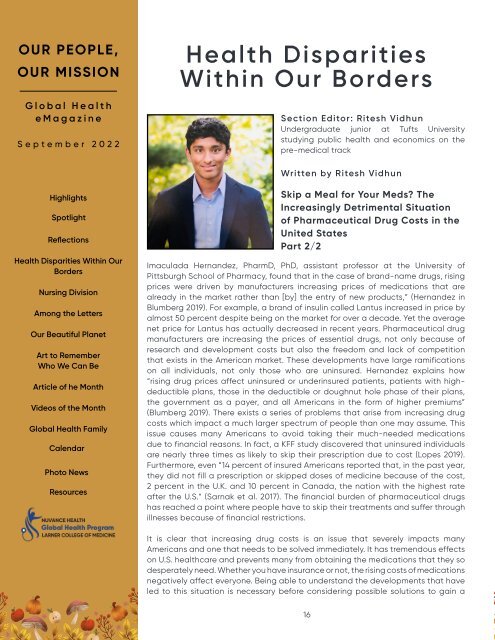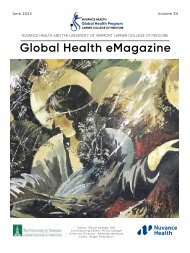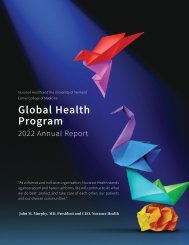eMagazine September 2022
You also want an ePaper? Increase the reach of your titles
YUMPU automatically turns print PDFs into web optimized ePapers that Google loves.
OUR PEOPLE,<br />
OUR MISSION<br />
Global Health<br />
<strong>eMagazine</strong><br />
<strong>September</strong> <strong>2022</strong><br />
Health Disparities<br />
Within Our Borders<br />
Section Editor: Ritesh Vidhun<br />
Undergraduate junior at Tufts University<br />
studying public health and economics on the<br />
pre-medical track<br />
Written by Ritesh Vidhun<br />
Highlights<br />
Spotlight<br />
Reflections<br />
Health Disparities Within Our<br />
Borders<br />
Nursing Division<br />
Among the Letters<br />
Our Beautiful Planet<br />
Art to Remember<br />
Who We Can Be<br />
Article of he Month<br />
Videos of the Month<br />
Global Health Family<br />
Calendar<br />
Photo News<br />
Resources<br />
Skip a Meal for Your Meds? The<br />
Increasingly Detrimental Situation<br />
of Pharmaceutical Drug Costs in the<br />
United States<br />
Part 2/2<br />
Imaculada Hernandez, PharmD, PhD, assistant professor at the University of<br />
Pittsburgh School of Pharmacy, found that in the case of brand-name drugs, rising<br />
prices were driven by manufacturers increasing prices of medications that are<br />
already in the market rather than [by] the entry of new products,” (Hernandez in<br />
Blumberg 2019). For example, a brand of insulin called Lantus increased in price by<br />
almost 50 percent despite being on the market for over a decade. Yet the average<br />
net price for Lantus has actually decreased in recent years. Pharmaceutical drug<br />
manufacturers are increasing the prices of essential drugs, not only because of<br />
research and development costs but also the freedom and lack of competition<br />
that exists in the American market. These developments have large ramifications<br />
on all individuals, not only those who are uninsured. Hernandez explains how<br />
“rising drug prices affect uninsured or underinsured patients, patients with highdeductible<br />
plans, those in the deductible or doughnut hole phase of their plans,<br />
the government as a payer, and all Americans in the form of higher premiums”<br />
(Blumberg 2019). There exists a series of problems that arise from increasing drug<br />
costs which impact a much larger spectrum of people than one may assume. This<br />
issue causes many Americans to avoid taking their much-needed medications<br />
due to financial reasons. In fact, a KFF study discovered that uninsured individuals<br />
are nearly three times as likely to skip their prescription due to cost (Lopes 2019).<br />
Furthermore, even “14 percent of insured Americans reported that, in the past year,<br />
they did not fill a prescription or skipped doses of medicine because of the cost,<br />
2 percent in the U.K. and 10 percent in Canada, the nation with the highest rate<br />
after the U.S.” (Sarnak et al. 2017). The financial burden of pharmaceutical drugs<br />
has reached a point where people have to skip their treatments and suffer through<br />
illnesses because of financial restrictions.<br />
It is clear that increasing drug costs is an issue that severely impacts many<br />
Americans and one that needs to be solved immediately. It has tremendous effects<br />
on U.S. healthcare and prevents many from obtaining the medications that they so<br />
desperately need. Whether you have insurance or not, the rising costs of medications<br />
negatively affect everyone. Being able to understand the developments that have<br />
led to this situation is necessary before considering possible solutions to gain a<br />
16


















